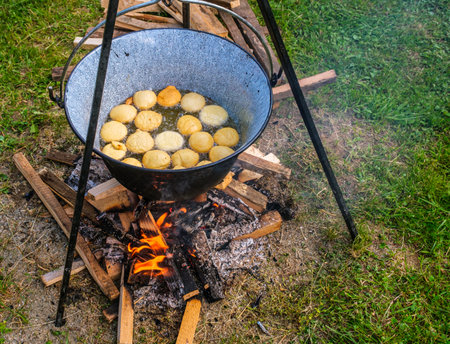1. Understanding Leave No Trace Cooking Principles
Cooking in the great outdoors is one of the best parts of camping, but it also comes with responsibility. The Leave No Trace (LNT) principles help outdoor enthusiasts minimize their impact on nature—and that includes how we prepare and enjoy our meals. Let’s break down how these guidelines apply to outdoor cooking.
Minimize Waste
One of the core LNT ethics is minimizing waste. This means reducing what you bring, packing out everything you pack in, and avoiding single-use items when possible. Here are some tips to help:
| Do | Dont |
|---|---|
| Use reusable containers and utensils | Bring disposable plates or plastic cutlery |
| Plan meals to avoid leftovers | Cook large portions that go uneaten |
| Pack out all food scraps and packaging | Bury or burn trash |
Respect Wildlife
Wild animals should never be fed or attracted by human food. Cooking smells and food scraps can lead to dangerous encounters for both people and animals. Follow these simple practices:
- Cook away from your sleeping area—at least 200 feet if possible.
- Store food in bear-proof containers or hang it in a tree if required.
- Clean up immediately after meals to avoid attracting critters.
Reduce Your Impact on Natural Environments
The way you cook can affect the land around you. Choose low-impact methods that preserve the environment:
Low-Impact Cooking Methods
| Method | Impact Level | Best Use Case |
|---|---|---|
| Camp stove (propane/alcohol) | Low | All environments, especially fragile areas |
| Established fire rings (where allowed) | Moderate | Campsites with existing fire pits |
| No-cook meals (e.g., cold sandwiches, dehydrated snacks) | Minimal | Backpacking trips or quick stops |
Avoid These Practices
- Building new fire rings or cooking directly on the ground.
- Using wood from the area unless its dead, down, and permitted.
- Dumping greywater into lakes or streams—strain and scatter it at least 200 feet away instead.
The goal of Leave No Trace cooking is simple: enjoy delicious meals outdoors while keeping nature just as beautiful for the next person—and for generations to come.
2. Planning Low-Impact Outdoor Meals
When youre heading out into the great outdoors, what you eat—and how you prepare it—can make a big difference in your environmental footprint. Planning low-impact meals helps reduce food waste, minimize trash, and avoid unnecessary cooking gear. With a little prep and the right ingredients, you can enjoy tasty meals without leaving a trace.
Think Ahead: Portion Control & Prepping at Home
Start by planning exact portions for each person and each meal. This avoids overpacking and wasting food. Prepping at home also reduces the need for bulky kitchen tools or large amounts of fuel at camp.
| Prep at Home | Benefits |
|---|---|
| Chop veggies & pre-cook grains | Saves time and fuel when cooking outdoors |
| Pre-measure spices & ingredients | Avoids bringing full containers and cuts down weight |
| Use reusable containers | Reduces single-use plastic and trash |
Choose Lightweight & Eco-Friendly Ingredients
Select foods that are light to carry, have minimal packaging, and cook quickly to conserve fuel. Focus on dry goods like rice, pasta, oats, or dehydrated meals that only require water to prepare.
Recommended Ingredients for Minimal Impact Cooking:
- Dried fruits & nuts: Great for snacking and energy, no refrigeration needed.
- Instant grains (quinoa, couscous): Quick to cook and lightweight.
- Powdered sauces & soups: Easy to pack and mix with hot water.
- Hard cheeses or cured meats: Last longer without refrigeration.
Avoid Excess Packaging
Repackage food into reusable containers or zip bags before your trip. Leave behind cardboard boxes or wrappers that create extra waste. This not only cuts down on trash but also makes packing more efficient.
Simplify Your Cooking Setup
You don’t need a full kitchen in the woods. One-pot meals are ideal—they save fuel, reduce dishwashing, and keep things simple. Try using a backpacking stove or small fire-safe grill if allowed in your area.
Simple One-Pot Meal Ideas:
- Lentil soup with dehydrated veggies
- Pasta with powdered cheese sauce and sun-dried tomatoes
- Couscous with chickpeas and olive oil packets
With smart planning and eco-friendly choices, your outdoor meals can be delicious, lightweight, and kind to nature.
![]()
3. Eco-Friendly Cooking Techniques
When youre out in the wild, how you cook your meals matters just as much as what you cook. Minimal impact cooking means preparing food in ways that protect nature and follow Leave No Trace principles. Let’s look at some eco-friendly techniques that help reduce your environmental footprint while still letting you enjoy tasty outdoor meals.
Use Portable Stoves Instead of Open Fires
Campfires might feel like a classic part of camping, but they can cause long-term damage to the environment. Open fires scar the ground, contribute to wildfire risks, and consume natural resources like fallen wood that wildlife depends on. The better choice? Portable stoves. They’re safer, more efficient, and leave no trace behind.
Benefits of Portable Stoves:
| Feature | Why It Matters |
|---|---|
| Fuel Efficiency | Uses less energy than open fires, reducing resource consumption. |
| No Ground Impact | Prevents fire rings or scorch marks on soil and vegetation. |
| Quick Setup | Saves time and effort when youre ready to eat. |
| Safer | Reduces risk of wildfires, especially during dry seasons. |
Try Cold Soaking for No-Heat Meals
If you want to skip cooking altogether, cold soaking is a great low-impact option. This method involves soaking dried foods like oats, couscous, or dehydrated meals in water for several hours until theyre ready to eat—no heat required!
Cold Soaking Basics:
- Gear Needed: Leak-proof container with a lid (like a screw-top jar or plastic container).
- Best Foods: Instant oats, ramen noodles, couscous, freeze-dried meals.
- Prep Time: Typically takes 30 minutes to a few hours depending on the food.
This method cuts down on fuel use entirely and is perfect for lightweight backpacking or short trips where every ounce counts.
Reduce Fuel Use and Heat Emissions
If you are using a stove, there are smart ways to make it even more eco-friendly. Reducing fuel use not only lightens your pack but also lessens your environmental impact.
Fuel-Saving Tips:
- Lid On: Always cook with a lid—it traps heat and cooks food faster.
- Wind Protection: Use a windscreen around your stove to prevent heat loss.
- Simplify Meals: Choose one-pot recipes that require less cooking time.
- Pre-Soak Ingredients: Soaking beans or grains ahead of time reduces cooking time on the trail.
The goal is to get the most out of your gear while leaving the least impact on nature. Every small step—like choosing a stove over a campfire or soaking your meals—adds up to big benefits for the environment.
4. Waste Management and Cleanup
When it comes to minimal impact cooking, managing your waste is just as important as what you cook or how you cook it. Following Leave No Trace principles means handling food scraps, gray water, and kitchen waste in a way that keeps nature pristine for the next camper. Heres how to do it right:
Food Scraps: Pack It Out
Even biodegradable food like fruit peels or bread crumbs should not be left behind. Wildlife may become dependent on human food or suffer health issues from eating things they shouldnt. Always pack out all leftover food.
Tips for Managing Food Scraps:
- Use a sealable trash bag dedicated for food waste
- Avoid over-preparing meals to reduce leftovers
- Scrape all uneaten food into your trash before washing dishes
Gray Water: Strain and Scatter
Gray water is the soapy water left after washing dishes or hands. This water often contains food particles and soap residue, which can harm wildlife and pollute natural water sources.
Steps for Safe Gray Water Disposal:
- Strain: Use a mesh strainer to remove all solid bits (add these to your trash)
- Scatter: Walk at least 200 feet away from any water source and scatter the strained water broadly across soil
Trash: Leave No Trace Means Carry It All Out
No matter how small, every piece of trash must go with you when you leave. That includes wrappers, twist ties, used paper towels, and even tiny bits like bread crusts or coffee grounds.
Packing Out Trash: What to Include
| Type of Waste | Packing Instructions |
|---|---|
| Food Scraps | Seal in a double-bagged container to prevent leaks and odors |
| Packing Materials | Squeeze flat to save space; separate recyclables if possible |
| Papertowels/Napkins | If greasy or dirty, treat as regular trash and pack out |
Campsite Cleanup Checklist
- Sweep the area for micro-trash (bits of foil, twist ties, etc.)
- Dismantle dishwashing stations and scatter strained gray water properly
- Tightly seal all trash bags and store them away from animals until departure
If everyone takes a few extra minutes to clean up thoroughly, we can all enjoy cleaner trails, healthier wildlife, and more beautiful campsites for years to come.
5. Respecting Wildlife and Other Campers
When youre cooking outdoors, its not just about making a great meal—its also about being a good neighbor to wildlife and fellow campers. Following minimal impact cooking techniques helps keep nature wild and campgrounds peaceful. Heres how you can cook responsibly while respecting the environment and others around you.
Store Food Safely
Proper food storage is essential for keeping animals away from your site and avoiding unwanted encounters with bears, raccoons, or even squirrels. Use the following methods based on where youre camping:
| Environment | Recommended Storage Method |
|---|---|
| National Parks with bear activity | Bear-proof lockers or canisters |
| Backcountry sites | Hang food bags at least 10 feet off the ground and 4 feet from tree trunks |
| Developed campgrounds | Coolers stored in vehicles with windows closed |
Avoid Attracting Wildlife
The smell of food can travel far, especially in quiet natural areas. To avoid attracting animals:
- Cook meals at least 200 feet away from your sleeping area
- Keep all trash, scraps, and packaging secured immediately after use
- Avoid cooking strong-smelling foods like bacon or fish in high-risk areas
Minimize Smells and Noise
Sensory pollution—like loud music or lingering food odors—can ruin the outdoor experience for others and disturb wildlife. Keep things chill by:
- Cooking quietly without loud conversations or devices playing music
- Cleansing cookware thoroughly to eliminate food residue smells
- Airing out used gear like grills or stoves away from communal areas
Campsite Courtesy Tips
| Do This | Avoid This |
|---|---|
| Tidy up cooking space right after meals | Leaving leftovers or trash behind overnight |
| Sweep up crumbs and dispose of waste properly | Burying food scraps (animals will dig them up) |
| Savor meals quietly during early mornings or late evenings | Loud music, shouting, or generators during quiet hours |
Your Role in Campground Harmony
A clean, respectful camper sets the tone for everyone else. Whether youre deep in the backcountry or enjoying a weekend at a family-friendly campground, practicing food safety and noise control shows respect for nature and your fellow adventurers.


